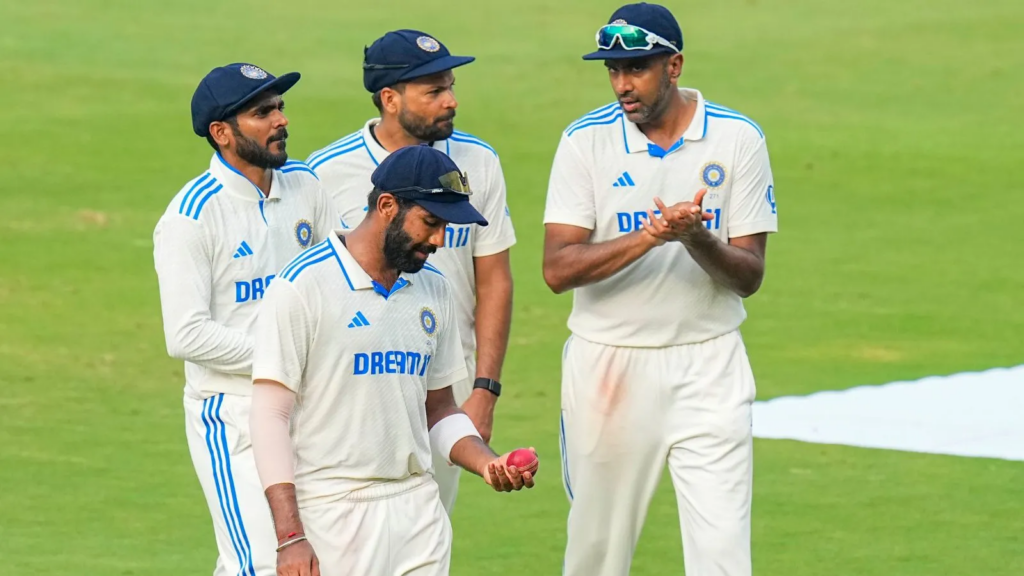India vs England: Jasprit Bumrah has struck telling blows to turn the tide and the series India’s way and humble high-flying England.
Jasprit Bumrah rarely gives interviews. Even when he does, he rarely opens up. Don’t read too much into that ever-present toothy smile, those giggly post-match interviews or his over-polite public school manners. There is more to him.
It’s his cryptic posts, candid comments picked by the stump mic, stray thoughts he shares with team mates on long podcasts and insights shared by those close to him that give a better idea about the Real Bumrah — the man responsible for demystifying the cult of Bazball and returning for the final Test after a break.
Under coach Brendon McCullum and captain Ben Stokes — England seemed to have achieved the impossible. They had convinced their fans, and other stakeholders that entertainment, and not winning, was the true essence of sport. That was until they landed in India and bumped into a proud bowler who had survived early rejections and toxic social media slander to be a one-of-a-kind modern day great pace bowler.
In the early part of the series, for the first-time since they got together, R Ashwin and Ravindra Jadeja seemed to have been mastered by a touring team. SOS was out, the panic button was about to be pressed. But just in time, Bumrah stepped up. And it wasn’t just him quickening his pace and sharpening his skills. What stopped the march of cricket’s newest hipsters was the ego and angst of Bumrah.
Also Read: Ronaldo’s Al-Nassr loses first leg of Asian Champions League quarterfinal!
Polite but proud
“He is the most polite player around and friendly too. But he is a bowler with a big ego. If he gets hit, expect a bouncer soon. He is very sensitive. He in his own silent way knows how to make a point,” says a franchise old hand.

This isn’t a new trait, it is something he had in him since the time he was just another young boy in Ahmedabad spending his evenings playing tennis ball cricket with friends.
“If we hit him for four or six, the next ball would either be a bouncer or beamer,” Mehta, an IT professional, had said.
Over the years, he has evolved. At 30, Bumrah is seen as a thinking pacer. He isn’t that naïve or one-dimensional to fall back on his oldest weapon, the yorkers, every time he is under pressure. But in this series, there was one yorker that will be remembered for long. It was easily the comeback moment of the series, one that will be talked about for years to come.
After his match-winning 196 at Hyderabad in the first Test, Ollie Pope had given England the momentum. India can be intimidated by aggression, believed the England dressing room. The world also saw Stokes as a pioneer, the messiah who had shown the way to those who failed on slow-low turning sub-continent tracks.
However, the notion lasted for just a Test. On the second day of the second Test, Bumrah bowled a special spell around tea time. He first shattered Pope’s stumps with a reverse swinging yorker that followed the trajectory that was once famously charted by Waqar Younis. Pope was on 23. Since that dismissal his scoring sequence has been 39, 3, 23, 23, 1.
Also Read: Hardik Pandya’s ‘returned home after 2 years’ comment set to intensify MI vs GT rivalry in IPL 2024!
In a spell that read 6-4-3-3, his other two wickets were Joe Root and Jonny Bairstow. At that point, the series took a turn, India had extinguished the flame that had threatened to burn down their Fort. Bumrah was also making an important point. When fit, he was India’s Man Friday. Those doubting him either didn’t know him or hadn’t made an effort to.
As is his wont, Bumrah, on that day at Vizag, didn’t yell in the face of Pope, Root or Bairstow to tell them how wrong they were in assuming that India had been caged. He was smiling, busy celebrating with his team mates. Even after the game, he preferred to stay dignified. Bumrah believes in pinning down his opponent into submission. Rubbing the nose in the ground, that’s not his style. His ego would have got hurt after the Hyderabad loss but the sight of flying stumps on the barmy Vizag day had healed it. That’s how Bumrah plays his sport.
Even when he makes a point, Bumrah is subtle.
At Rajkot in the third Test, England were chasing 557 in the fourth innings. The Bazball demon still hadn’t been slayed, the bravado and swagger hadn’t yet left Stokes and his believers.
Opener Ben Duckett had made the outlandish remark of Yashasvi Jaiswal learning attacking cricket from them. James Anderson was taking pains to tell the media that the team’s philosophy was still about winning at all costs, that is losing included. He shared with the media that the Baz in Bazball, coach McCullum, had told the team that even if England had to chase 600, they would go for it.
Also Read: Ravindra Jadeja’s mind-games that outclassed former Australia batter: ‘You guys think…’
Fate had granted them the wish, at Rajkot they would get a target in that range. But England were unable to walk the talk. They would have a nightmarish start. They were 28/3 and the game was just 11 overs old.
Now Bumrah had Joe Root in front of him. He didn’t seem in an adventurous mood. Bumrah, maybe anticipating some Root innovative hit, bowled an off-cutter. The batsman, instead, would defend it. Bumrah was amused, he looked at this captain and said: “Ab toh maar hi nahi rahe hai (They are not looking to hit now)”. The voice amplified by the stump mic would reach around the cricketing world. An important statement was being made in the most casual and deferential tones. This was Bumrah passing a judgment — the pulse was low, Bazball was breathing heavily.
During the series, in his moment of triumph, Bumrah would show bitterness, expressing his disappointment in the way he has been treated. It was clear, in his mind, the champion bowler thought that he hadn’t got a fair deal.
After the second Test, when he topped the ICC Test ranking, he showed his angst. His Instagram post had two pictures – one of a jam-packed cricket stadium and the other was a lone spectator sitting among empty seats. The first was labelled “The Congratulations” and the other “The Support”. Once again Bumrah was being dignified as he reminded everyone how he didn’t have support when he needed it most.
For most of last year when Bumrah was nursing a career-threatening injury, he was constantly trolled. Memes were made about how he had missed India games but would get miraculously fit for IPL. This India-England series, Bumrah had to make a point. Of late, he had seen another setback. Despite the experience of being the India captain for a tour recently, despite being loyal to Mumbai Indians, he didn’t replace Rohit Sharma as captain. That privilege went to Hardik Pandya, who MI redrafted from Gujarat Titans. It was around this time, Bumrah would write another puzzling post – “Silence sometimes is the best answer.”
A man of few words, Bumrah’s real communication with his fans and others is through his bowling. Those yorkers, the kind he got Pope with, are loud and direct taunts to his fickle fans and those doubting his skills. In the final Test here, the pacer has a chance to end debates about commitment and caliber.
Six years back Bumrah had made his Test debut under the Table Mountain to rattle a strong South African batting line-up. Now under the gaze of snowy Dhauladhar in Dharamsala, he has a chance to further undermine Bazball’s street cred. Flanked by the enchanting yet echoing hills, he can also carefully whisper to the world a reminder that they shouldn’t celebrate just his peaks.
This article is originally published on Indianexpree.com!








